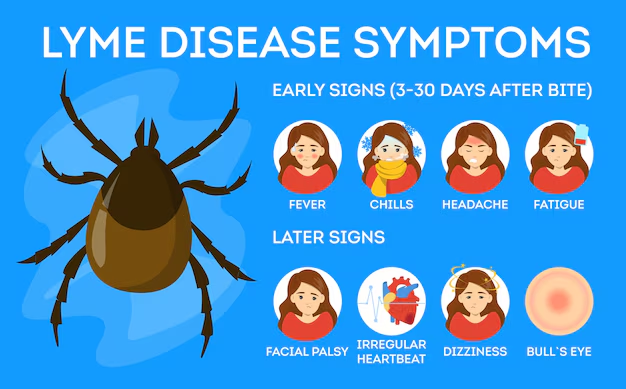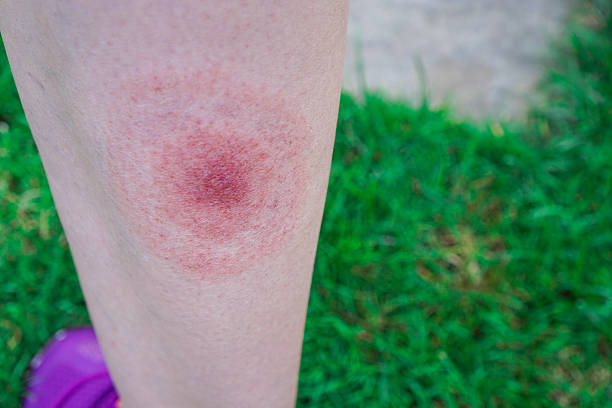Early Signs of Lyme Disease
Key Symptoms to Watch For


Lyme disease is most common in many parts of the world. Do you know why it is so important to know the early signs of lyme disease? Lets see in detail here in this blog, how to identify the early stages of lyme illness and its importance and the effects if left unnoticed.
Lyme illness is spread by the bite of ticks. It is common that you would hear about this disease when you are visiting forested or woody grassy areas. Let’s get into more detail about where and when to look for them, and proactive measures to take when such infection is suspected.
What Is Lyme Disease?
Lyme disease is caused by the bite of black legged ticks commonly called deer ticks. When the tick bites a bacteria named Borrelia burgdorferi, gets transmitted into blood through it and causes infection. This bacteria multiplies and penetrates into various organs of our body system and results in serious illness. But the complications of serious illness can be prevented if diagnosed at the early stage.
Now, moving forward let’s analyze the ways for early lyme detection and distinguish the symptoms associated with the disease.
How Lyme Disease Begins: Early Signs to Watch For
The early signs of lyme disease can go unnoticed because it has symptoms similar to that of other diseases like flu. But it is important to consider the early signs carefully otherwise it may leave you in a serious condition or complications in treatment. Let’s look into some of the key symptoms that you need to know and monitor carefully at the early stage.
Tick bite bull’s eye rash: It is also known as Erythema Migrans(EM). It takes 3 to 30 days to develop in the body post a tick bite.
- It looks like bull’s eye in circular or enlarged oval shape
- It looks like reddish ring like in the top skin and bluish hue in the bottom skin

Flu-like Symptoms: If a person is infected with lyme, they may experience muscle pain, chills, fevers, and even fatigue. These symptoms are similar to flu virus so, it is crucial to identify whether these feelings develop after a tick bite or not.
Joint pain: In the initial stages it is possible to have mild joints especially in the large joints like the knee or other areas and cause discomfort.
The Importance of Recognizing Early Lyme Symptoms
Why is early detection considered crucial for Lyme illness? When Lyme condition is undiagnosed and left untreated it may result in complications that affect the heart, nervous system and joints. As the days progresses it may also other lyme disease symptoms like
- Swollen Lymph Nodes: A swelling around the neck, or armpits may be noted.
- Headaches: Persistent or severe headaches together with sensitivity to light.
- Unexplained Fatigue: Mild tiredness with no apparent reason occurs frequently even after adequate rest during the early stages of the illness.
Addressing the symptoms with timely treatment with antibiotics during this stage is often highly effective, making early Lyme detection essential.
What Does a Tick Bite Rash Look Like?

The primary indicator of tick bite is the bull’s eye rash. Note that all individuals may get these signs and make it difficult to understand to find out at the early stage. In such cases it is crucial to understand the variations in its symptoms.
- In most cases, the rash is not itchy or painful but feels warm to the touch.
- This rash may fade on its own with some just dismissing it as a nuisance.
If you find this rash developing, especially after a tick bite, consult your physician right away.
How to Differentiate Lyme Disease Symptoms From Other Illnesses?
The major challenge in the case of Lyme disease is that the symptoms may resemble some other health conditions. For instance muscle pain, fever, tiredness but let’s see how to distinguish it.
Fever:
Although fever is common, in Lyme disease, it occurs together with a rash or some other specific symptoms.
Fatigue:
Lyme-induced fatigue feels more intense and enduring.
Localized Pain:
Joint or muscle pain tends to be asymmetrical and localized in Lyme disease.
If these symptoms follow a tick bite, do not consider them as a seasonal flu with proper investigation.
Brain Fog and Lyme Disease
Brain fog is one of the common symptoms of Lyme illness. As the Borrelia bacteria is transmitted through the blood, it causes inflammation in various organs of the body. It also affects the brain resulting in mental confusion, memory, and concentration issues
Research and studies have found the lyme patients experiencing abnormal brain activities. It was identified using techniques such as MRIs and PET scans. Rather than mere exhaustion it bacteria alters brain activity leading to cognitive impairment.
This symptom of brain fog results from inflammation and structural damage to the brain. To treat the infection, antibiotics will be advised by your doctor. These may reduce inflammation which would promote healing and mental acuity.
The Connection Between Lyme Disease and Fatigue
One may experience fatigue even after taking enough rest with Lyme disease. It is the most incapacitating feature of the illness. This is because the Borrelia bacteria trigger an inflammatory reaction that affects the neurological system of the body.
Moreover, these symptoms are negatively impacted by co-infections such as babesiosis, which makes recovery challenging for patients.
- The main causes of fatigue are the inflammation in the immune system and the impact that bacteria have on energy control.
- It is not alleviated by normal rest and requires medical assistance.
- It can be reduced by the treatment of co-infections and antibiotics in the infection.
Impact of Lyme Disease on the Nervous System
Severe nervous system issues and Neuroborreliosis are two outcomes of Lyme disease. This causes inflammation and nerve damage resulting in meningitis, cognitive impairment, and facial paralysis, also known as Bell’s palsy. If left untreated, Lyme disease can lead to long-term neurological problems.
- The bacteria transmitted in the blood penetrate the blood-brain barrier to cause inflammation in the neurological system.
- The administration of antibiotics is timely in preventing permanent damage.
Steps to Take After a Tick Bite

If you suspect you have got a bite from the tick, do follow the steps carefully:
- Remove the Tick Safely: With the help of fine-tipped tweezers, grasp the tick as close to your skin as possible and pull it steadily upwards.
- Clean the Bite Area: Use soap and running water to wash it off or rub some alcohol on the affected area.
- Monitor for Symptoms: Ensure for a tick bite rash, flu-like symptoms, or other Lyme disease signs.
- Consult a Doctor: If symptoms appear, seek medical advice promptly for early Lyme detection.
When to Seek Medical Help?
Even though it does not require any medical emergency unless it is if you find any symptom develops as follows:
- A rash that looks peculiar or unusual skin changing areas that show a tick bite.
- Flu-like feeling that doesn’t get better.
- Pain or swelling in affected joints that are intense.
It is always best to seek doctor advice. Antibiotics prescribed at an early stage means one doesn’t have to suffer the chronic stage of Lyme disease.
Living With Lyme Disease: Coping and Recovery
The chances of complete recovery for patients with lyme disease depends on how early it is diagnosed and treated effectively. Supportive measures that can help with this conditions includes,
Rest and Hydration:
To manage fatigue and improvement in healing.
Physical Therapy:
For persistent soreness or stiffness in the joints after treatment.
Emotional Support:
To support yourself from the stress caused due to Lyme disease.
The Key Takeaway
Staying informed about Early Signs of Lyme Disease, common Lyme disease signs like the tick bite rash and flu-like symptoms, can help act immediately and get effective treatment. It helps to protect yourself and your loved one from getting affected seriously. Remember, prevention is always better than suffering, spend your outdoors mindfully, observe the early signs carefully if suspected. Early action can make all the difference.
